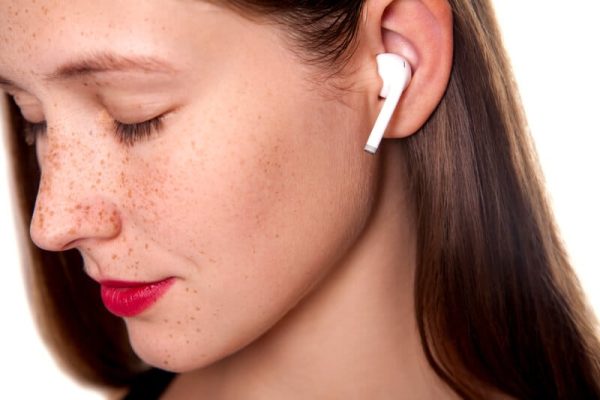Your cart is currently empty!

Are AirPods Safe? The Truth & EMF Health Risks of Wireless Earpods
Last Updated on February 20, 2024

AirPods. You see them everywhere.
In subways, at the gym, on airplanes, in the office, in classrooms and on campus, and even walking on sidewalks.
AirPods and other wireless Bluetooth headphones have seemingly taken over people’s ears.
Responsible for your unresponsive neighbor or passerby, these small yet recognizable earpods are easy to spot nearly everywhere you go.
In 2017, over 368 million headphones and headsets were sold worldwide. 2017 was also the year that Apple released their wireless AirPods, which have since become Apple’s most popular accessory. This sales statistic is estimated to double by 2021, and with new versions of AirPods set to release in the future, sales are predicted to climb even more.
Despite the rise in popularity, AirPods may not be all they’re cracked up to be, in more ways than one.
Many critics believe AirPods are overpriced, have subpar sound quality, have a short life span, and have a frightening, negative impact on the planet.
Additionally, from a personal health standpoint, AirPods expose your head to constant wireless Electromagnetic Field (EMF) radiation.
AirPod EMF Radiation Emissions
EMF radiation is a form of energy emitted wirelessly from all mobile devices, and is created by WiFi, Bluetooth, and cell tower connections. Current research shows that these emissions have proven health risks.
Recently, AirPods have been featured in various publications, not only for their rising popularity but also for reports showing that their Bluetooth transmitters can send dangerous electrical signals through the brain.
Many argue this claim is unsubstantiated or overblown.
In terms of the pros and cons of wireless earpods, some think the risk of EMF exposure is well worth the benefits. Consumers certainly enjoy the convenience of wireless and hands-free accessories; however, some remain cautious about wireless headphones, and are hesitant to use them for more than a short workout or quick call, or even buy them at all.
While research on wireless earpod radiation has not yet developed since AirPods’ release in 2017, having Bluetooth EMF radiation that close to your brain and body makes AirPods a potentially dangerous way to listen to music, podcasts, movies, and phone calls.
Issues with Wireless Bluetooth Radiation & AirPod Health Safety Concerns
Bluetooth is a form of Radio Frequency (RF) radiation (2.4 to 2.485 GHz) that works by sending data through the air over short distances via audio, video, and text.
Most wireless Bluetooth headphones are “Class 2”, which can emit energy up to 33 feet; however, the effective range of Bluetooth varies due to a range of conditions.
Generally, Bluetooth operates at a lower intensity than cellular signals; however, this does not mean they are safe.
It was once thought that cellular signals are too low to affect the body, but now we know that the body does react to these electromagnetic waves, and that it cannot tell the difference between the levels of cellular versus Bluetooth radiation.
Additionally, AirPods are designed to be placed directly in the ear for long periods of time. Sometimes people keep them in all day, even when they aren’t being used! The placement of the AirPods and the length of contact increases the EMF radiation to one’s head, and more people are taking note of the possible subsequent dangers.
In 2011, The World Health Organization International Agency for Research on Cancer (IARC) advised that electromagnetic radiation from wireless devices constitutes a possible human carcinogen.
In 2019, more than 250 scientists signed a petition calling for the International Public Health Organization to create stronger guidelines on wireless devices. This appeal is a result of the increasing popularity of wireless devices that emit EMF radiation, such as Apple’s AirPods.
The number of AirPod users is expected to reach 55 million this year, and as this number climbs, this particular group of scientists is expressing their concerns over the public’s increased exposure to EMF generated by these and other wireless devices.
In this petition, scientists cite various studies showing the following negative health effects of EMF radiation:
Those are just the most permanent and impactful effects, but many other symptoms have been associated with EMF exposure.
Why EMF Safety Standards Aren’t Really Safe
Most wireless devices, including Apple AirPods, actually comply with legal limits for EMF frequency emissions, regulated in the U.S. by the Federal Communications Commission, or FCC.
However, the scientists who signed the petition — as well as many others, both in Government and in research — believe that the guidelines are too lax. They argue that the FCC favors its top industry, the Telecom industry, and that the current standard (from 1996) does not apply to the recent generations of wireless networks and devices.
Additionally, the FCC measures how safe radiation emissions are based on how much the emissions can thermally heat up cells in your body, called the Specific Absorption Rate, or SAR.
The first issue with this method is that the SAR standard was tested on a 200-pound adult male, and doesn’t take into account smaller or younger bodies, which are more susceptible to the radiation.
Secondly, EMF radiation can have a biological effect on cells, in addition to its ability to heat the cells.
Many are calling for stricter guidelines and insist that the public be informed about the risks created by RF waves, which are already stated in tiny print in cell phone manuals. Not only should guidelines be revised regarding the risks that AirPods and other wireless devices have on our body, but also regarding the hazardous risks to the planet.
AirPods Effect on the Environment

As futuristic as AirPods may seem, AirPods are actually a product of the past.
AirPods are plastic, made of a combination of elements created 13.8 billion years ago. Humans extract these elements from the Earth, heat these elements, refine them, and assemble them, in this case, into white, peg-like earphones.
Long after you leave this Earth, AirPods will live on because the plastic shell of AirPods take up to 1,000 years to decompose in landfills. A millennium later, someone may discover these AirPods and wonder what their purpose was.
In 2019, we should examine the same questions.
Plastic straws are being banned for the same reasons of overproduction and unsustainable use, so when will we realize that many other plastic products are equally as unnecessary, convenient as they might be?
For approximately a year and a half, AirPods do their job – play music, facilitate phone calls, and so forth.
However, in standard Apple fashion, AirPods slowly become unusable because their battery stops holding its charge. Worse, they are unfixable because the product is essentially glued together. Furthermore, AirPods are unrecyclable because there is not a safe, nontoxic way to detach the battery from the plastic shell.
Instead, the 55 million AirPods predicted to be bought this year are set to become pieces of waste, sans purpose, becoming an environmental problem of Apple’s own design.
Mother Earth continues the uphill battle regarding disposable plastic products.
Disposable Product, Disposable Labor?
The 18-month lifespan of AirPods reflect the reality of their production – AirPods are built by disposable labor.
Disposable labor refers to the workers who temporarily meet the production demand for a product or service, but when this product or service is no longer in need, these people are no longer in need either. Much like the product itself, they are replaceable. Needless to say, there is a human cost involved in extracting and refining the materials to make AirPods.
According to Business Insider, Foxconn is a Chinese company that assembles an estimated half of all Apple products. As of May 2018, about 350,000 people worked in the facilities for salaries as low as $300 per month, or about $10 a day. For years, Apple sourced Cobalt and Tantalum from the Democratic Republic of the Congo, and only after lengthy accounts of child labor, staff grievances and worker deaths did Apple stop sourcing these materials from small mines in the Congo.
As workers suffer at the hands of AirPod creation, consumers are next in line to experience the prospective consequences of this product, too, from the moment they place these pods into their ear canals.
Location of the Bluetooth Transmitter & Why it Matters
All EMF radiation from electronics can be harmful, but some mobile devices are riskier than others. A good rule of thumb is that the closer you are, the more dangerous electronics become. AirPods, and their placement in the ear canal, win the title for being the closest electronic device to a very valuable and sensitive organ, your brain.
Dr. Andrew Goldsworthy, a retired lecturer from the Imperial College of London, one of the top three UK universities after Oxford and Cambridge, documented how the short wavelengths and quick rise-and-fall times of pulsing among Bluetooth headsets can damage human cells. Thus, exposure to high-frequency EMFs from a high-powered Bluetooth headset, such as AirPods, can cause permanent DNA damage and increase the risk of cancer.
Wireless AirPods rest snugly in the ear, therefore positioning the source of radiation emissions, the Bluetooth transmitter, directly in the ear canal in both ears.
Standard Bluetooth headphones, on the other hand, have a wire running from one ear canal to the other ear canal with one transmitter near the nape of the neck.


So, although all Bluetooth headphones pose harm after long periods of use, the location of AirPods’ transmitters makes them the most harmful headphone option.
Jerry Phillips, a Biochemistry professor at the University of Colorado, signed the above-mentioned petition and explained that the placement of the AirPods in the ear canal exposes the tissues in the head to high amounts of EMF radiation which poses a risk for tumors and other conditions linked to abnormal cell functioning.
Other Health Concerns Related to EMF Exposure to the Head
In addition to the concerns of DNA damage and Cancer, there are many additional health concerns related to EMF exposure to the head.
-
ADHD
EMF radiation is said to generate inward Calcium leakage in the brain’s neurons. This leakage stimulates hyperactivity, making one less capable of concentrating on tasks, thus resulting in attention deficit hyperactivity disorder (ADHD).
According to Dr. Goldsworthy, leakage of the cells of the peripheral nervous system in adults makes them send false signals to the brain, which results in the symptoms of Electromagnetic Hypersensitivity. Further exposure could then tip those sensitive over the edge into full symptoms of electromagnetic intolerance.
-
Early Dementia and Alzheimer’s Disease
The inward leakage of Calcium ions from EMFs also opens the junction barriers in our bodies.
Normally, these barriers protect the body from allergens in the environment and prevent toxic materials in the bloodstream from entering sensitive parts of the body such as the brain. However, the opening of these barriers has been shown to cause the death of neurons, resulting in early Dementia and Alzheimer’s disease.
-
Tinnitus
Tinnitus is the perception of noise or ringing in the ears, and it affects 15 to 20% of people. Tinnitus is actually a symptom, not a condition, of an underlying condition such as ear injury or a Circulatory system disorder. Bluetooth headphones have been linked to the development of Tinnitus.
Safer Ways to Listen
The symptoms and health effects of wireless headphones are certainly disadvantageous to one’s health. Although wireless AirPods may be convenient, safer ways of listening do exist. You can reduce EMF radiation to the head by opting for traditional wired headphones, or you can eliminate EMF radiation to the head altogether with Air Tube headphones.
-
Traditional Wired Headphones
When plugging traditional headphones into a signal source such as a laptop or cell phone, an electrical signal travels up the wire of the headphones, only becoming sound upon reaching the speaker in your ear.
In turn, this signal produces Extremely Low-Frequency (ELF) Radiation that emits from the headphones.
ELF Radiation is considerably less intense and more controlled than a Bluetooth signal that travels through the air.
However, scientists have tested and continue to test headphones, and several articles illustrate that ELF radiation can still be harmful with long-term exposure.
Many expert groups advise prevention in light of these concerns by taking the simple precaution of exercising awareness regarding the distance of EMF radiation to the brain and body. Thus, one should be mindful when frequently using wireless AirPods.
-
Air Tube Headphones
To fully eliminate the EMF radiation traveling into your ear and head from headphones, consider another alternative to AirPods: EMF-Free Air Tube headphones.
Air Tube Headphones deliver sound via hollow air tubes instead of through traditional wires. Before the signal reaches your head, the speakers convert the electrical signal to an acoustic signal. Then, the acoustic signal is sent through flexible, hollow air tubes to your earbuds (free of metal conductors and essentially zero Gauss, since no electrical conduction or EMF transmission takes place).
Be Aware, Be Mindful
Unfortunately, nearly all digital systems, including AirPods, use electromagnetic pulses within the range of 6Hz and 600Hz, which research has shown to create damaging biological effects.
However, it isn’t hard to make your daily electromagnetic environment safer. Employing simple strategies like avoiding direct contact with mobile devices when possible, keeping them far away from you or turning them off when not in use, and only using them for short periods of time can have a large positive effect on you and your family.
Using EMF radiation shields for your cell phone, tablet, and laptop, and Air Tube headphones can help prevent direct contact with pulsed RF and ELF EMF emissions.
When using AirPods, or any other wireless headphones, folks should employ the precautionary principle and be mindful of short- and long-term environmental, humanitarian, and bodily effects that can be caused by wearing them.
Related Posts
None found



























